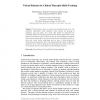Free Online Productivity Tools
i2Speak
i2Symbol
i2OCR
iTex2Img
iWeb2Print
iWeb2Shot
i2Type
iPdf2Split
iPdf2Merge
i2Bopomofo
i2Arabic
i2Style
i2Image
i2PDF
iLatex2Rtf
Sci2ools
IVA
2007
Springer
2007
Springer
Virtual Patients for Clinical Therapist Skills Training
Virtual humans offer an exciting and powerful potential for rich interactive experiences. Fully embodied virtual humans are growing in capability, ease, and utility. As a result, they present an opportunity for expanding research into burgeoning virtual patient medical applications. In this paper we consider the ways in which one may go about building and applying virtual human technology to the virtual patient domain. Specifically we aim to show that virtual human technology may be used to help develop the interviewing and diagnostics skills of developing clinicians. Herein we proffer a description of our iterative design process and preliminary results to show that virtual patients may be a useful adjunct to psychotherapy education.
| Added | 08 Jun 2010 |
| Updated | 08 Jun 2010 |
| Type | Conference |
| Year | 2007 |
| Where | IVA |
| Authors | Patrick G. Kenny, Thomas D. Parsons, Jonathan Gratch, Anton Leuski, Albert A. Rizzo |
Comments (0)

